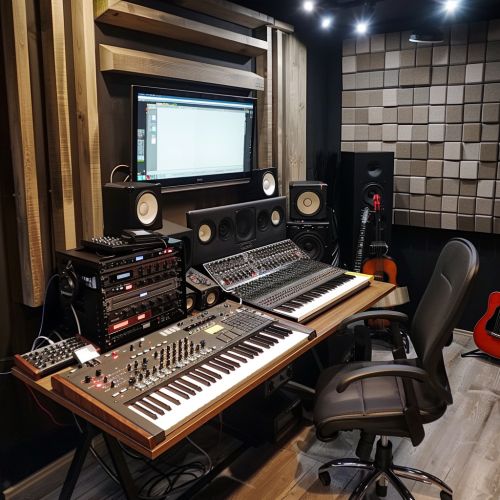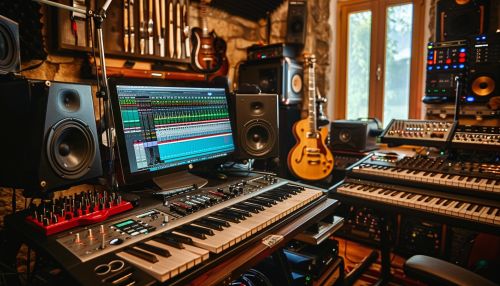Digital Audio: Difference between revisions
(Created page with "== Introduction == Digital audio is a representation of sound recorded in, or converted into, digital form. In digital audio, the sound wave of the audio signal is typically encoded as numerical samples in a continuous sequence. This process involves the conversion of analog sound waves into a digital format that can be manipulated, stored, and transmitted by digital devices. The field of digital audio encompasses a wide range of technologies and applications, from the r...") |
No edit summary |
||
| Line 53: | Line 53: | ||
Digital audio has revolutionized the music production industry. Modern digital audio workstations (DAWs) allow musicians and producers to record, edit, and mix music with unprecedented precision and flexibility. Digital audio effects and virtual instruments have expanded the creative possibilities for artists. | Digital audio has revolutionized the music production industry. Modern digital audio workstations (DAWs) allow musicians and producers to record, edit, and mix music with unprecedented precision and flexibility. Digital audio effects and virtual instruments have expanded the creative possibilities for artists. | ||
[[Image:Detail-92013.jpg|thumb|center|Recording studio with digital audio workstation and various musical instruments.|class=only_on_mobile]] | |||
[[Image:Detail-92014.jpg|thumb|center|Recording studio with digital audio workstation and various musical instruments.|class=only_on_desktop]] | |||
=== Broadcasting === | === Broadcasting === | ||
Latest revision as of 14:41, 18 June 2024
Introduction
Digital audio is a representation of sound recorded in, or converted into, digital form. In digital audio, the sound wave of the audio signal is typically encoded as numerical samples in a continuous sequence. This process involves the conversion of analog sound waves into a digital format that can be manipulated, stored, and transmitted by digital devices. The field of digital audio encompasses a wide range of technologies and applications, from the recording and playback of music to telecommunications and digital signal processing.
History of Digital Audio
The concept of digital audio dates back to the early 20th century, but it was not until the 1960s and 1970s that significant advancements were made. The development of digital audio was driven by the need for higher fidelity and more efficient storage and transmission of audio signals. Early pioneers in the field included engineers and researchers who developed the first digital audio recording systems and digital signal processing techniques.
Early Developments
The first practical digital audio recording system was developed by Dr. Thomas Stockham in the late 1960s. Stockham's system, known as the Digital Audio Recorder (DAR), used a computer to digitize and store audio signals. This system laid the groundwork for future advancements in digital audio technology.
The Advent of the Compact Disc
The introduction of the compact disc (CD) in the early 1980s marked a significant milestone in the history of digital audio. Developed by Sony and Philips, the CD provided a high-quality, durable, and portable medium for storing and playing back digital audio. The success of the CD paved the way for other digital audio formats and technologies.
Digital Audio Technologies
Digital audio encompasses a wide range of technologies and processes, including analog-to-digital conversion, digital signal processing, and digital audio formats. Each of these technologies plays a crucial role in the creation, manipulation, and playback of digital audio.
Analog-to-Digital Conversion
Analog-to-digital conversion (ADC) is the process of converting analog audio signals into digital form. This process involves sampling the analog signal at regular intervals and quantizing the amplitude of each sample into a discrete value. The quality of the digital audio signal depends on the sampling rate and bit depth used in the conversion process.
Sampling Rate
The sampling rate, or sample rate, is the number of samples taken per second from the analog signal. It is measured in hertz (Hz). Common sampling rates include 44.1 kHz (used for CDs) and 48 kHz (used for professional audio). Higher sampling rates can capture more detail from the original analog signal.
Bit Depth
Bit depth refers to the number of bits used to represent each sample. It determines the dynamic range and resolution of the digital audio signal. Common bit depths include 16-bit (used for CDs) and 24-bit (used for professional audio). Higher bit depths provide greater dynamic range and more accurate representation of the original signal.
Digital Signal Processing
Digital signal processing (DSP) involves the manipulation of digital audio signals using mathematical algorithms. DSP techniques are used in a wide range of applications, including audio compression, noise reduction, and effects processing. DSP can be performed in real-time or offline, depending on the application.
Audio Compression
Audio compression is the process of reducing the size of digital audio files without significantly affecting their quality. Compression can be lossless, where no information is lost, or lossy, where some information is discarded to achieve higher compression ratios. Common audio compression formats include MP3 (lossy) and FLAC (lossless).
Noise Reduction
Noise reduction techniques are used to remove unwanted noise from digital audio signals. These techniques can be applied during recording, post-production, or playback. Common noise reduction methods include spectral subtraction, adaptive filtering, and noise gating.
Digital Audio Formats
Digital audio can be stored and transmitted in various formats, each with its own advantages and disadvantages. Some of the most common digital audio formats include:
WAV
WAV (Waveform Audio File Format) is a standard audio file format used for storing uncompressed audio data. It is widely used in professional audio applications due to its high quality and compatibility with various software and hardware.
MP3
MP3 (MPEG-1 Audio Layer III) is a popular lossy audio compression format. It is widely used for storing and transmitting music due to its relatively small file size and acceptable audio quality.
FLAC
FLAC (Free Lossless Audio Codec) is a lossless audio compression format. It provides high-quality audio without any loss of information, making it suitable for archiving and high-fidelity audio playback.
AAC
AAC (Advanced Audio Coding) is a lossy audio compression format that offers better sound quality than MP3 at similar bit rates. It is widely used in streaming services and digital media players.
Applications of Digital Audio
Digital audio technology has a wide range of applications across various industries. Some of the most common applications include music production, broadcasting, telecommunications, and multimedia.
Music Production
Digital audio has revolutionized the music production industry. Modern digital audio workstations (DAWs) allow musicians and producers to record, edit, and mix music with unprecedented precision and flexibility. Digital audio effects and virtual instruments have expanded the creative possibilities for artists.


Broadcasting
Digital audio is widely used in broadcasting, including radio, television, and online streaming. Digital audio broadcasting (DAB) provides higher sound quality and more efficient use of the radio spectrum compared to traditional analog broadcasting. Internet radio and podcasting have also benefited from advancements in digital audio technology.
Telecommunications
Digital audio plays a crucial role in telecommunications, including voice over IP (VoIP) and mobile communication. Digital audio compression and error correction techniques ensure clear and reliable voice transmission over digital networks.
Multimedia
Digital audio is an essential component of multimedia applications, including video games, movies, and virtual reality. High-quality digital audio enhances the immersive experience for users and provides more realistic soundscapes.
Future Trends in Digital Audio
The field of digital audio continues to evolve, driven by advancements in technology and changing consumer demands. Some of the emerging trends in digital audio include:
High-Resolution Audio
High-resolution audio (HRA) refers to audio recordings with higher sampling rates and bit depths than standard CD quality. HRA aims to provide a more accurate and detailed representation of the original sound, appealing to audiophiles and music enthusiasts.
Spatial Audio
Spatial audio technology creates a three-dimensional sound experience, allowing listeners to perceive sound from different directions and distances. This technology is used in virtual reality, augmented reality, and immersive audio applications.
Artificial Intelligence
Artificial intelligence (AI) and machine learning are increasingly being used in digital audio applications. AI algorithms can analyze and process audio signals, enabling advanced features such as automatic music transcription, audio restoration, and personalized sound profiles.
Conclusion
Digital audio has transformed the way we create, store, and experience sound. From its early beginnings to the latest advancements, digital audio technology continues to shape the future of music, broadcasting, telecommunications, and multimedia. As technology continues to evolve, the possibilities for digital audio are limitless.
